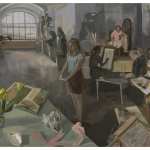In the NY Times, Roberta Smith reports that the artists included in �How Soon Is Now?” the 28th version of the annual culmination of the Bronx Museum�s Artist in the Marketplace, or AIM, program for emerging artists, need to think more deeply about the art they’re making before they begin to address career advancement. “The show is a cacophony of mediums, materials and styles. The only relief, initially, are a few paintings or painting-like objects,” Smith writes. “In this rather undifferentiated morass of feints at video, photography, sculpture and above all earnestly political, identity-based Conceptual Art, the paintings spring out like little oases of personal thought, concentration and effort. Some nonpainting efforts come into focus with time, but the first impression is a telling lesson in why painting doesn�t die; it is at the very least a good way for young artists to grasp the kind of density of expression that any art medium requires. (It helps to remember that most of the first generation Conceptualists were educated and began their careers as painters.)…Perhaps an overfamiliarity with Conceptual Art and especially the theories it inspired can leave young artists with no sense of how to make an artwork that holds together as an experience. You can sense the lack of connection to either materials or self in their statements, which appear on the wall labels beside the work. They mix overblown, one-size-fits-all artspeak with quite a bit of wishful thinking about their work�s impact, as if they could control the meaning or effect of their work. Different artists claim that their efforts ‘contend with codes of power, authority, race and class,’ ‘question man-made constructs,’ ‘challenge the anthropological categorizations of early photography’ or ‘reveal the latent power of the public�s collective intelligence.’…
“Not much else here will slow you down. It does gives me pause that 26 of the 36 artists have master�s degrees in fine arts from respected universities or art schools. I think most of them should ask for their money back. On the evidence here, at least, they have only a meager understanding of what being an artist entails. ‘How Soon Is Now?’ suggests that there is no point in spending time on ‘professional development’ or learning how to advance one�s work in the marketplace if artistic development is not well under way. That requires lots of long, hard looking at all kinds of art, in all mediums, from all periods and cultures. Aspiring artists need to expose themselves to the sheer intensity and variety of art, to learn what they love, what they hate and if they are actually artists at all. New York�s galleries and especially its great museums offer ample opportunity for this kind of self-education, which leads to self-knowledge. Anything is possible when artists set to work knowing they have something they urgently need to say, in a way it hasn�t quite been said before.” Read more.
“How Much is Now?,” organized by Erin Riley-Lopez. The Bronx Museum of the Arts, New York, NY. Through August 18. Artis include Negar Ahkami , Blanka Amezkua, Keliy Anderson-Staley,Daniel Bejar,Charles Beronio,Matthew Burcaw,Si Jae Byun,Brendan Carroll ,Vidal Centeno,Margarida Correia,R� di Martino, Emcee C.M., Master of None,Jason Falchook , Michelle Frick, David Gilbert, Kyung Woo Han, Cosme Herrera, Catherine Kunkemueller, Luke Lamborn, Sujin Lee, Bill Lohre, Rebecca Loyche, Giuseppe Luciani, Brian Lund, Kelli Miller, Laura Napier, Dulce Pinzon, Christy Powers, Risa Puno, Ronny Quevedo, Sa�dia Rehman, John Richey,Irys Schenker, Mark Stafford, Jeanne Verdoux, Angie Waller
Image at top: Jeanne Verdoux, “Living Room,” 2008, drawn animation and wire. Courtesy of NYTimes















‘I think most of them should ask for their money back’
That cracked me up.
Also, it’s not fair to entirely blame the artists. Erin picked them and the faults are partly down to her selection.
I could be wrong about this, not knowing the artists in the show, but maybe the curators should start looking at the artists who got their MFA 's in the 80's and the 90's or earlier back when their wasn't so much hype around the MFA, Sorry but I sometimes feel frustrated that the hype is there, Makes it unfortunate for me that I got my MFA when I did, then on the other hand I am so glad I went when I did, I am a far better painter for the experience I had.
Dear Roberta Smith…
I should be thrilled to ask for my money back, if only I thought there was a snowball's chance in hell they would give it to me. I learned little in grad school that i did not learn on my own. What I was taught by Professors was that they were failed artists who never developed their work because they were far too busy chasing a job, meeting the right people and learning to play the part. In short what they taught me was that I did not wish to be like them. Perhaps this means I am not an artist. That is okay. Given that most of the people I went to school with have stopped making work except for the ones who didn't make work during school but instead associated their way to stardom I think your advice is sound. I thank you for your efforts but I would add that it wont help, even one of your own relatives made it further on his association to you than he did in developing his work. His work was crap, everyone knew it. His association with you GAVE him the time to develop into something. ANYONE could develop into something were they given that time. The system is fundamentally flawed and the academic system is now mostly just a place for third tiered elites to have a job a dupe unsuspecting "students" from the hinter-lands into paying their way through life. As long as this is the case you will continue to get what you currently have. The problem is systemic and the system should be put down.